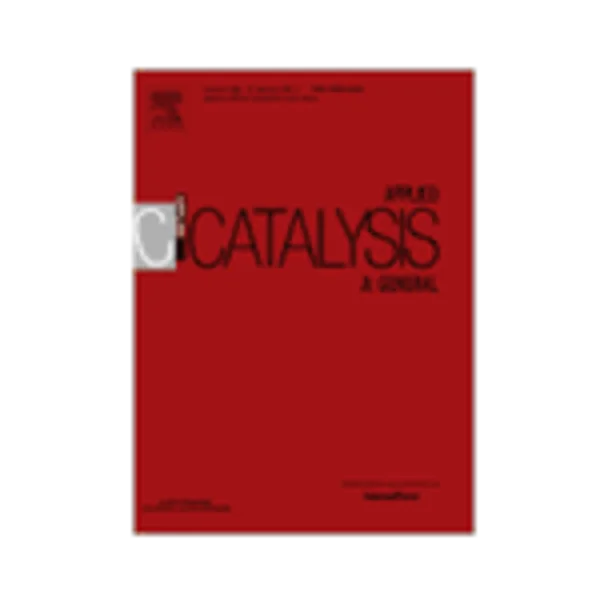-
the influence of citric acid on the synthesis and activity of high surface area mop for the hydrodeoxygenation of 4-methylphenol
جزئیات بیشتر مقاله- تاریخ ارائه: 1392/07/24
- تاریخ انتشار در تی پی بین: 1392/07/24
- تعداد بازدید: 1037
- تعداد پرسش و پاسخ ها: 0
- شماره تماس دبیرخانه رویداد: -
the influence of citric acid on the synthesis and activity of high surface area mop for the hydrodeoxygenation of 4-methylphenolunsupported, high surface area mop was synthesized by adding citric acid (ca) to solutions of ammonium heptamolybdate and diammonium hydrogen phosphate followed by drying (397 k), calcination (773–973 k), and reduction in h2 (923 k). a tetrameric mo citrate precursor was formed after drying which decomposed into a monomer of the form, mo(c4h5o3cn)o2·hpo4 following calcination. reduction of this monomer produced ch4, co, co2, nh3, h2o, and mop. the c content of the reduced mop-ca catalysts decreased from 12.8 to 4.0 wt% as the calcination temperature increased from 773 to 973 k, whereas the surface area decreased from 136 m2/g to 53 m2/g and the mop particle size increased from 5 to 9 nm, respectively. the residual c acted as a structural promoter of the calcined samples, limiting agglomeration of the mop crystallites during reduction so that nanoparticles (5–9 nm) of mop were produced. the hdo of 4-methylphenol over the mop-ca catalysts was found to be structure insensitive with an initial turnover frequency (tof) of 0.079 s−1 at 623 k and 4.4 mpa h2. the ratio of hydrogenation to direct deoxygenation of 4-methylphenol (tofhyd:tofddo = 0.78:1) was independent of the mop particle size and greater than that observed over mos2.
مقالات جدیدترین رویدادها
-
استفاده از تحلیل اهمیت-عملکرد در ارائه الگوی مدیریت خلاقیت سازمانی و ارائه راهکار جهت بهبود
-
بررسی تاثیر ارزش وجوه نقد مازاد بر ساختار سرمایه شرکت های پذیرفته شده در بورس اوراق بهادار تهران
-
بررسی تأثیر سطح افشای ریسک بر قرارداد بدهی شرکت های پذیرفته شده در بورس اوراق بهادار تهران
-
بررسی تأثیر رتبه بندی اعتباری مبتنی بر مدل امتیاز بازار نوظهور بر نقد شوندگی سهام با تأکید بر خصوصی سازی شرکت ها
-
تأثیر آمیخته بازاریابی پوشاک ایرانی بر تصویر ذهنی مشتری پوشاک ایرانی (هاکوپیان)
-
حسابداری منابع انسانی و افزایش کارایی و اثربخشی بهره وری در سازمان
-
بررسی اندیشه های کامران دیبا در طراحی فرهنگسرای نیاوران
-
رهیافت های زیبایی در پایداری شهر (با نگاهی به ارزش های کالبدی بافت تاریخی)
-
تاثیر فعالیت های لرزه ای در ناپایداری شیروانی های سنگی در منطقه آوج
-
بررسی تأثیر آموزش بر تغییر قند خون بیماران دیابتی
مقالات جدیدترین ژورنال ها
-
مدیریت و بررسی افسردگی دانش آموزان دختر مقطع متوسطه دوم در دروان کرونا در شهرستان دزفول
-
مدیریت و بررسی خرد سیاسی در اندیشه ی فردوسی در ادب ایران
-
واکاوی و مدیریت توصیفی قلمدان(جاکلیدی)ضریح در موزه آستان قدس رضوی
-
بررسی تاثیر خلاقیت، دانش و انگیزه کارکنان بر پیشنهادات نوآورانه کارکنان ( مورد مطالعه: هتل های 3 و 4 ستاره استان کرمان)
-
بررسی تاثیر کیفیت سیستم های اطلاعاتی بر تصمیم گیری موفق در شرکتهای تولیدی استان اصفهان (مورد مطالعه: مدیران شرکتهای تولیدی استان اصفهان)
-
بررسی ضرورت کشاورزی شهری در راستای دستیابی به برنامه ریزی سلامت در کلان شهر مشهد
-
بررسی رابطه بین ابعاد رهبری پدرسالارانه و آوای سازمانی با تاکید بر نقش تعدیل کننده تسهیم دانش کارکنان شعب بانک صادرات استان گلستان
-
مکانیزم جایگاه قرینه و تبیین دلالت اثبات دعاوی
-
تأثیر تسهیم دانش، تمایل به یادگیری و فناوری اطلاعات بر فراموشی سازمانی هدفمندبا مطالعه نقش تعدیل گر عدالت سازمانی ادراک شده
-
an examination of crash severity differences between male and female drivers, using logistic regression model




سوال خود را در مورد این مقاله مطرح نمایید :